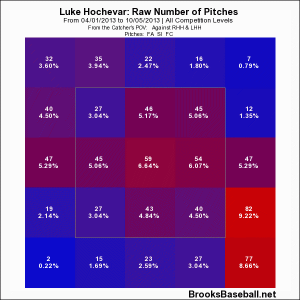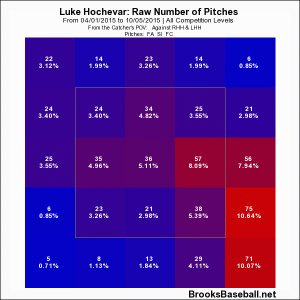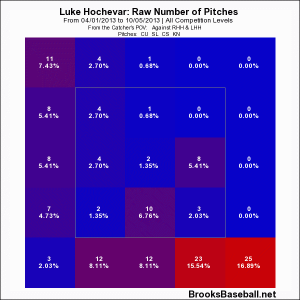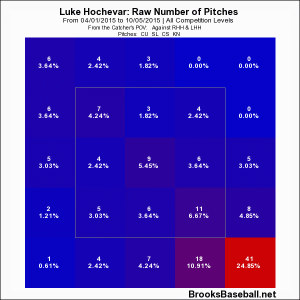Last season, Ryan Madson went from non-roster invitee to questionable roster addition to critical piece of puzzle in less than two months. In doing so, Madson provided the Royals with a ‘sixth-inning man’ and, more importantly, a fourth arm to throw into the late inning mix when one of the big three at the back end needed a day off. Beyond that, as Greg Holland fought through and eventually was completely derailed by injury, Madson was there to fill the void as Wade Davis and Kelvin Herrera shuffled back an inning in games.
Madson is gone and Holland is out for the year, but Dayton Moore reloaded the big three by signing Joakim Soria and no doubt is hoping the ‘Madson void’ might be filled by old friend Luke Hochevar. It is a tremendous luxury that the Royals’ largest bullpen concern is who the fourth guy in line might be, but it might also be more critical on a team like Kansas City that has a good deal of skepticism around its starting rotation.
Hochevar was on his way to what appeared to be a very successful conversion to the bullpen before being sidelined for all of 2014 with Tommy John surgery. In 2013, his very first ever as a reliever, Luke destroyed opposing hitters. He struck out 10.49 batters per nine innings, his velocity jumped three miles per hour (as you might expect) and his walk rate was lower than it ever had been as a starter. Batters swung and missed over 13% of the time and had no luck even when they did put the ball in play.
For the last month of 2013, Hochevar was given the eighth inning and owned it. He was Wade Davis, before Wade Davis was Wade Davis. At least for one month, anyway.
Hochevar post-surgery in 2015 was not quite the same. In fact, he was pretty average. The strikeout rate was down, so were the swings and misses. The walk rate was up and Hochevar was okay, but not the reliever he had been two seasons prior.
Now, Hochevar did throw 10.2 scoreless post-season innings, allowing just six hits. He inherited four runners and allowed none of them to score. Luke appeared in four of the five World Series games, allowing just two hits over five innings – including the final two of the the game that gave Kansas City its first World Championship in 30 years. All of that came, however, with Hochevar striking out just four hitters in those nearly 11 post-season innings.
I searched for some change in Hochevar that caused his post-season to be so much more effective than his 2015 regular season. For something to show us, other than velocity, as to why Luke was so good, so promising in 2013 and so very average in 2015. Quite honestly, the easiest explanation may be the best: Hochevar was working his way back from Tommy John. If you want to look in a different direction, could subtle changes in the location of Luke’s pitches have contributed to the problem.
Here is a look at Hochevar’s fastballs (this includes the cutter), the first chart being 2013 and the second from last season:
What I see is Hochevar’s fastball – be it intentional or lack of control – has moved more out of the strike zone. Gut reaction from a guy in the stands? Luke challenged hitters with hard stuff over the plate in 2013, then got them to chase out of the zone. In 2015 he flirted with the edge of the zone, spent less time out over the plate and got less bang for his buck when he went or stayed outside of the strike zone.
Hochevar’s curveball, which as a reliever is his only off-speed offering, shows us the following (again, 2013 first):
In a not uncommon maneuver, Hochevar predominately throw his curve to get hitters to chase it down into the dirt. The primary spot for Luke’s curve between 2013 and 2015 remained the same, but he spread the curve all across the bottom of the grid in 2013, but pretty much just stayed in one corner in 2015.
These are subtle differences to be sure, but possibly just enough of a change to make the difficult job of hitting major league pitching a little easier for opponents last season. It also, again to this guy up in the stands, seems to point to a pitcher who either was uncertain of his stuff coming back from injury or simply not able to throw his pitches where he wanted to.
Is it unreasonable to assume Hochevar might well revert to his 2013 form, now that he has full season of work under his belt post-Tommy John? No, but it might be worth noting this his velocity remains more 2015-esque than the crisp 96+ we saw often in 2013.
Sound the alarm? Certainly not, but it is worth monitoring what Hochevar gives the Royals the first few months of the season. It would be ideal if his effectiveness allowed Ned Yost to trust Luke in the late innings as a periodic replacement for a tired Soria, Herrera or Davis.
It would also be ideal if the Ned Yost had Hochevar available to fill that role as opposed to having to continually pitch the sixth inning. That, however, is a discussion for another day.





I remember way back when, you (or maybe Craig?) did a story on Hochevar’s “Atomic Slider”…for some reason, I remember thinking his revamped slider was at least a partial contributor to his success after he moved to the bullpen in 2013? Or was this written back when he was still a starter? Am I remembering this old blog post correctly? How does his slider look pre and post TJ surgery? Thanks Clark.
Wow. Outstanding memory. That was written about his second half of the 2011 season. Spoiler alert: His success didn’t take. He’s abandoned the pitch since moving to the pen.
Link